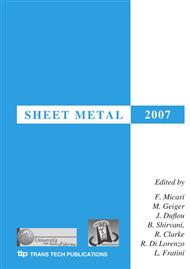p.669
p.677
p.685
p.693
p.699
p.707
p.715
p.723
p.731
Numerical Prediction of the Shape of the Molten Pool in a Stationary TIG Welding Process
Abstract:
A numerical model of the electric arc is coupled to a model for the convective flow in the molten pool of a stainless steel sheet during a stationary TIG welding process. This approach allows us to predict the shape of the bead, which is determined by the balance between the Marangoni forces on the free surface and the radial drag from the arc jet impingement. The surface tension of the molten steel is greatly influenced by its temperature and sulphur content, as experiments showed very different bead shapes associated to the same welding parameters. We simulate three sulphur contents, namely 10 ppm, 40 ppm and 100 ppm, showing their effects on the velocity and temperature distributions in the molten pool. A transition between drag-dominated and surface tension-dominated pools is found at a sulphur content of few dozens, in agreement with previous experimental observations.
Info:
Periodical:
Pages:
699-706
Citation:
Online since:
July 2007
Authors:
Price:
Сopyright:
© 2007 Trans Tech Publications Ltd. All Rights Reserved
Share:
Citation:


